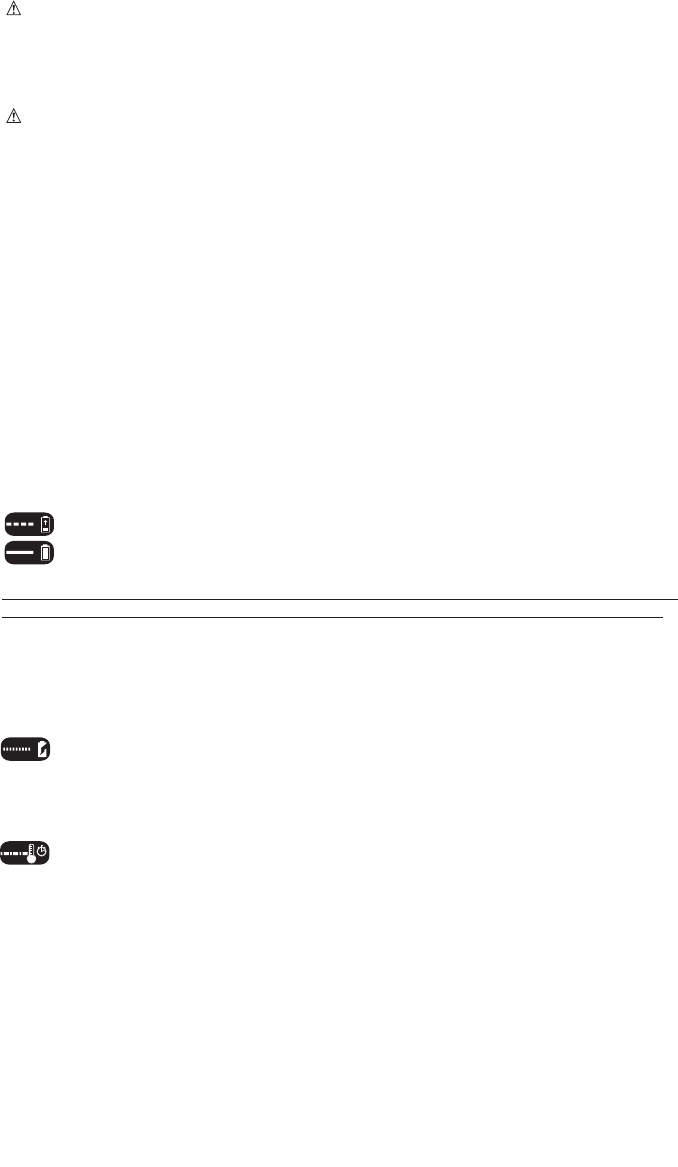
WARNING:
Never attempt to open the battery pack for any reason. If battery pack
case is cracked or damaged, do not insert into charger. Do not crush, drop or damage
battery pack. Do not use a battery pack or charger that has received a sharp blow, been
dropped, run over or damaged in any way (i.e., pierced with a nail, hit with a hammer,
stepped on). Damaged battery packs should be returned to service center for recycling.
WARNING: Fire hazard. Do not store or carry battery so that metal objects
can contact exposed battery terminals. For example, do not place battery in aprons,
pockets, tool boxes, product kit boxes, drawers, etc., with loose nails, screws, keys, etc.
Transporting batteries can possibly cause fires if the battery terminals
inadvertently come in contact with conductive materials such as keys, coins, hand
tools and the like. TheUSDepartmentofTransportationHazardousMaterial
Regulations(HMR)actuallyprohibittransportingbatteriesincommerceoronairplanes
(i.e., packed in suitcases and carry-on luggage) UNLESS they are properly protected
from short circuits. So when transporting individual batteries, make sure that the battery
terminals are protected and well insulated from materials that could contact them and
cause a short circuit. NOTE: Li-Ion batteries should not be put in checked baggage.
Storage Recommendations
1. The best storage place is one that is cool and dry away from direct sunlight and
excess heat or cold.
2. Long storage will not harm the battery pack or charger, but batteries should be
charged at least once every 12 months.
Charging Procedure
BOSTITCH chargers are designed to charge BOSTITCH battery packs.
1. Plug the charger into an appropriate outlet before inserting the battery pack.
2. Insert the battery pack into the charger.
3. The LED will flash indicating that the battery is being charged.
4. The completion of charge is indicated by the LED remaining on continuously.
The pack is fully charged and may be used at this time or left on the charger.
Recharge discharged batteries as soon as possible after use or battery life may
be greatly diminished. For longest battery life, do not discharge batteries fully. It is
recommended that the batteries be recharged after each use.
Charger Diagnostics
This charger is designed to detect certain problems that can arise with the battery packs
or the power source. Problems are indicated by one LED flashing in different patterns.
Bad Battery
The charger can detect a weak or damaged battery. The LED flashes in the
pattern indicated on the label. If you see this bad battery blink pattern, do not
continue to charge the battery. Return it to a service center or a collection site
for recycling.
Hot/Cold Pack Delay
When the charger detects a battery that is excessively hot or excessively cold,
it automatically starts a Hot/Cold Pack Delay, suspending charging until the
battery has normalized. After this happens, the charger automatically switches to
the Pack Charging mode. This feature ensures maximum battery life. The light
flashes in the pattern indicated on the label.
Leaving the Battery in the Charger
The charger and battery pack can be left connected with the LED glowing indefinitely.
The charger will keep the battery pack fresh and fully charged. This charger features
an automatic tune-up mode which equals or balances the individual cells in the battery
pack to allow it to function at peak capacity. Battery packs should be tuned up weekly or
whenever the battery no longer delivers the same amount of work. To use the automatic
tune-up mode, place the battery pack in the charger and leave it for at least 8 hours.
7


















